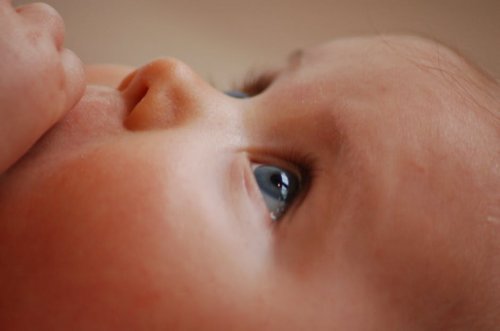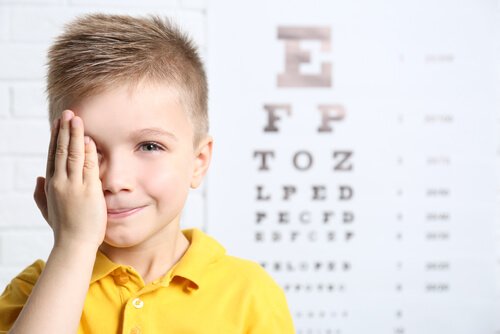Droopy Eyelids: Causes and Treatments

Droopy eyelids are also known as ptosis. This condition occurs when the eyelid sags lower than it should, which can affect your child’s vision either partially or totally.
It can happen in one or both of the eyes, and can be the result of congenital and other factors. In this article, we’ll tell you what you need to know about droopy eyelids.
What are the causes?
There are a variety of causes that can be related to droopy eyelids. Some of the main ones include:
- Congenital: when the elevating muscle of the eyelid doesn’t develop completely during the baby’s gestation.
- Birth: the baby’s eyelid muscle can be affected by the use of forceps, an instrument used to help deliver the child.
- Eye movement disorders: these are linked to problems with the muscles that affect eye movement.
- Brain and nervous system issues: sometimes ptosis can result from a cerebral anomaly or a neuromuscular illness affecting the eyes.
- Inflammation: there are also factors unrelated to a deficiency in the muscles controlling the eyelids, including the growth of tumors in the eyelid, allergies, traumas, and conjunctivitis.

The most common symptoms
Droopy eyelids are usually detected at approximately six months of age, due to the fact that the baby spends more time awake, and can be more expressive with his or her face.
If the child suffers from ptosis, the following symptoms are usually present:
- Leaning the head back to see: when this occurs the little one can also suffer from chronic torticollis.
- Elevating the eyebrow: in order to lift the droopy eyelid.
- Excessive teariness: exaggerated production of tears.
- Loss of vision: partial or total blindness.
Consequences of droopy eyelids in babies and children
Ptosis isn’t a serious condition. However, if the eyelids come to cover the pupil either partially or completely, it can compromise the child’s vision, and produce some of the following problems:
- Amblyopia or lazy eye: this creates diminished vision in one or both of the child’s eyes.
- Strabismus or squinting: this is a condition where the eyes don’t point in the same direction, or in the case of squinting, they cross due to the infant’s deficient control over his or her eye muscles.
“If parents notice that their little one has a droopy eyelid, or an eyelid that sags or closes suddenly, they should contact a specialist immediately.”
Treatment
Generally speaking, the only effective treatment for droopy eyelids is a surgical intervention. There are no exercises or medications to strengthen the muscle that controls the movement of the eyelids.
However, according to the Institute of Ocular Microsurgery, a child with congenital ptosis should receive periodic check-ups from birth. An ophthalmologist should evaluate the condition and consider what procedure to pursue.
- Periodic check-ups: these are necessary in cases of congenital ptosis (from birth) in order to ensure the early detection of any resulting ailment.
- Occlusion of the healthy eye: in the event that the condition requires optical correction with lenses due to amblyopia (diminished vision), doctors will proceed to cover the healthy eye in an effort to force the affected eye to compensate.
- Surgical intervention: specialists suggest that this should wait until the child is three, four, or even five, because it means that he or she will be able to cooperate more. However, in cases of vision loss, it’s done immediately, regardless of age.

Recommendations
When children have drooping eyelids, the first thing to do is to take them to a pediatrician. According to the American Academy of Ophthalmology, it’s vital that the parents address the problem promptly. This is the best way to avoid complications that can lead to permanent vision loss in one or both eyes.
The doctor will then refer you to a specialist, who will proceed to carry out the relevant tests and make a diagnosis in order to determine the appropriate treatment. Parents need to follow the specialist’s recommendations in order to get optimal results.
It’s best if corrective treatment takes place during early childhood, even before the child starts school. This way, you can prevent the condition from having an effect on their academic performance, as well as their social development.
When parents notice any anomaly in their child, it’s essential that they consult a local specialist. This measure is a fundamental part of preventing lasting damage to the child’s health.
Droopy eyelids are also known as ptosis. This condition occurs when the eyelid sags lower than it should, which can affect your child’s vision either partially or totally.
It can happen in one or both of the eyes, and can be the result of congenital and other factors. In this article, we’ll tell you what you need to know about droopy eyelids.
What are the causes?
There are a variety of causes that can be related to droopy eyelids. Some of the main ones include:
- Congenital: when the elevating muscle of the eyelid doesn’t develop completely during the baby’s gestation.
- Birth: the baby’s eyelid muscle can be affected by the use of forceps, an instrument used to help deliver the child.
- Eye movement disorders: these are linked to problems with the muscles that affect eye movement.
- Brain and nervous system issues: sometimes ptosis can result from a cerebral anomaly or a neuromuscular illness affecting the eyes.
- Inflammation: there are also factors unrelated to a deficiency in the muscles controlling the eyelids, including the growth of tumors in the eyelid, allergies, traumas, and conjunctivitis.

The most common symptoms
Droopy eyelids are usually detected at approximately six months of age, due to the fact that the baby spends more time awake, and can be more expressive with his or her face.
If the child suffers from ptosis, the following symptoms are usually present:
- Leaning the head back to see: when this occurs the little one can also suffer from chronic torticollis.
- Elevating the eyebrow: in order to lift the droopy eyelid.
- Excessive teariness: exaggerated production of tears.
- Loss of vision: partial or total blindness.
Consequences of droopy eyelids in babies and children
Ptosis isn’t a serious condition. However, if the eyelids come to cover the pupil either partially or completely, it can compromise the child’s vision, and produce some of the following problems:
- Amblyopia or lazy eye: this creates diminished vision in one or both of the child’s eyes.
- Strabismus or squinting: this is a condition where the eyes don’t point in the same direction, or in the case of squinting, they cross due to the infant’s deficient control over his or her eye muscles.
“If parents notice that their little one has a droopy eyelid, or an eyelid that sags or closes suddenly, they should contact a specialist immediately.”
Treatment
Generally speaking, the only effective treatment for droopy eyelids is a surgical intervention. There are no exercises or medications to strengthen the muscle that controls the movement of the eyelids.
However, according to the Institute of Ocular Microsurgery, a child with congenital ptosis should receive periodic check-ups from birth. An ophthalmologist should evaluate the condition and consider what procedure to pursue.
- Periodic check-ups: these are necessary in cases of congenital ptosis (from birth) in order to ensure the early detection of any resulting ailment.
- Occlusion of the healthy eye: in the event that the condition requires optical correction with lenses due to amblyopia (diminished vision), doctors will proceed to cover the healthy eye in an effort to force the affected eye to compensate.
- Surgical intervention: specialists suggest that this should wait until the child is three, four, or even five, because it means that he or she will be able to cooperate more. However, in cases of vision loss, it’s done immediately, regardless of age.

Recommendations
When children have drooping eyelids, the first thing to do is to take them to a pediatrician. According to the American Academy of Ophthalmology, it’s vital that the parents address the problem promptly. This is the best way to avoid complications that can lead to permanent vision loss in one or both eyes.
The doctor will then refer you to a specialist, who will proceed to carry out the relevant tests and make a diagnosis in order to determine the appropriate treatment. Parents need to follow the specialist’s recommendations in order to get optimal results.
It’s best if corrective treatment takes place during early childhood, even before the child starts school. This way, you can prevent the condition from having an effect on their academic performance, as well as their social development.
When parents notice any anomaly in their child, it’s essential that they consult a local specialist. This measure is a fundamental part of preventing lasting damage to the child’s health.
This text is provided for informational purposes only and does not replace consultation with a professional. If in doubt, consult your specialist.








